Brilliant New Supernova Shatters Cosmic Records For Brightness, Energy, And Even Mass

How does one supernova get so bright, so energetic, and so massive? It’s a spectacular mystery to solve.
On February 22, 2016, one of humanity’s automated sky-scanning telescopes — the Pan-STARRS Survey for Transients — reported a bright new signal appearing in the sky, just slightly over the threshold from visible light into the infrared. It was immediately curious because it came from an empty region of the sky: where no stars or galaxies were known, meaning that if there was a galaxy out there, it was so faint and distant that we hadn’t yet discovered it.
After more than 3 years of follow-up analysis, scientists have finally revealed what must have occurred: the brightest, most energetic supernova humanity has ever seen. According to a new paper published on April 13, 2020 in Nature Astronomy, this likely arose from one of the most massive stars in the entire Universe, perhaps the most massive one we’ve ever observed go supernova. Inside, it holds a clue to the first supernovae of all: the ones arising from the very first stars in the Universe.
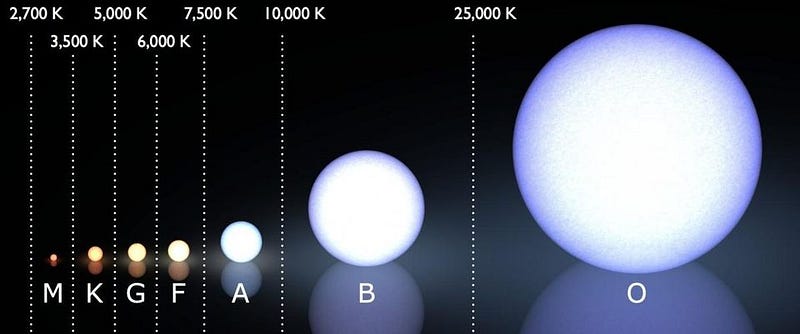
In general, there are two ways to make a supernova. Whenever a star is born, it starts off with a certain amount of mass, and that mass typically determines its fate. Either:
- it’s born with between 8% and 40% of the Sun’s mass, in which case it will slowly burn hydrogen and then contract and fade away, becoming a helium white dwarf,
- or it’s born with between 40% and about 800% of the Sun’s mass, where it will burn through its hydrogen, become a helium-burning red giant, and then gently blow off its outer layers and contract down to a carbon-and-oxygen white dwarf,
- or it’s born with 8 times (or more) the mass of the Sun, in which case it will burn through hydrogen, helium, carbon, oxygen, etc., until its core implodes and collapses, triggering a runaway reaction and a supernova explosion.
The ones that become white dwarfs, if either the white dwarf accretes enough matter or merges with another white dwarf, get “second chances” to go supernova as well.
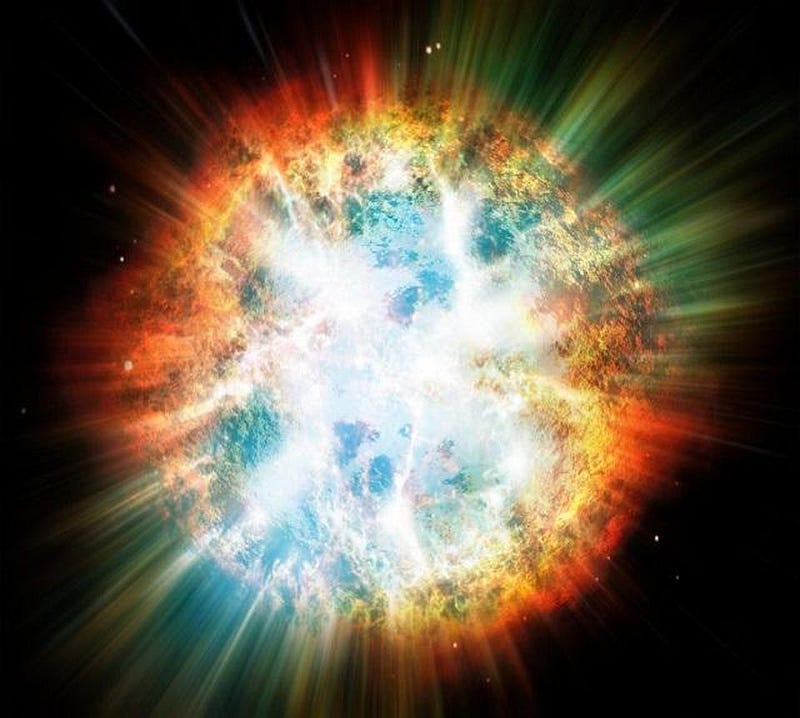
There are a few things all supernovae have in common. They all involve runaway fusion reactions, where lighter elements are fused into heavier ones, creating a large fraction of many of the heaviest elements of the periodic table found throughout the Universe. Normally, they brighten, reach a peak brightness, and then fall off, with their brightness dependent largely on how far away they are from us.
The ones that arise from white dwarfs, in particular, obey a standard pattern, which means if we observe how that brightness rises, peaks, and falls, we can learn how far away that object must be. This is the astronomical idea of a “standard candle,” where if we know how bright something is intrinsically (say, from its light curve) and how much its light is shifted from the Universe’s expansion (say, from its redshift), we can determine how far away it is. This is one of the key clues we’ve uncovered in figuring out what the Universe is made of and how its expansion has evolved over time.
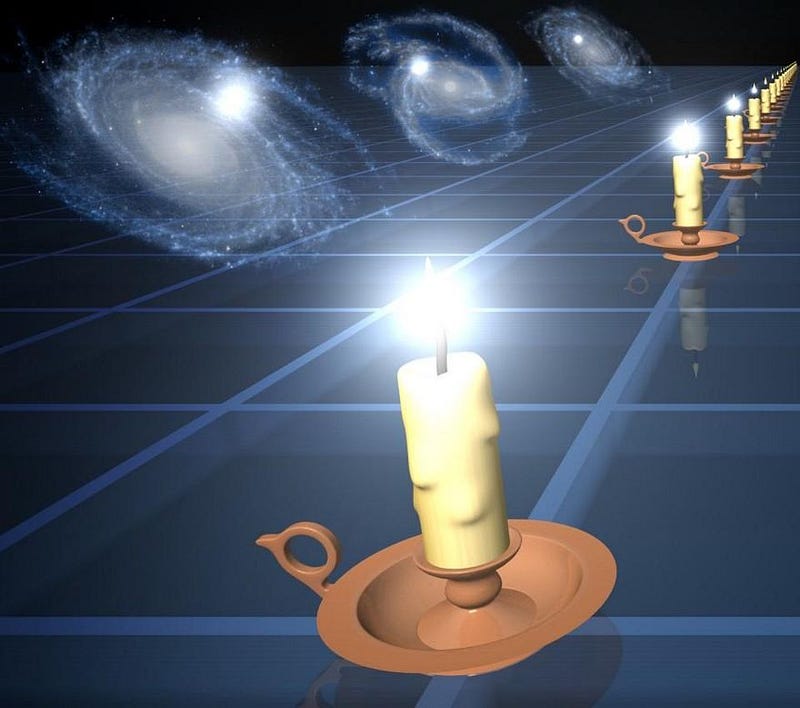
Typical supernovae radiate only about 1% of their energy in visible light, and typically give off a total explosion energy equivalent to what the Sun emits over its ~10 billion year lifespan. That’s impressive, to be sure, and represents one of the most energetic ways a star can meet its demise. But every once in a while, a supernova comes along that surprises us in terms of brightness and energy: one that’s a cosmic outlier.
Specifically, the ones that are even brighter and more energetic than these typical cosmic cataclysms are known as superluminous supernovae, with many ideas flying around as to what causes them. Could they be very massive stars that expel material, and then when the supernova occurs, the blast wave smashes into that material? That’s a scenario that seems to align with Eta Carinae, the most famous “supernova impostor” we’ve ever seen.

On the other hand, there’s the idea that superluminous supernovae arise from the pair-instability mechanism. In general, the more massive your star is, the hotter the core temperature gets as the star evolves. Beyond a certain threshold, the energies rise so high that collisions between individual photons and particles carry enough energy that they can spontaneously produce new particle-antiparticle pairs, specifically of electrons and positrons, through Einstein’s E = mc².
When that energy threshold gets crossed, some of those energetic photons are converted into matter (and antimatter), causing the internal radiation pressure to drop. That leads to the core contracting and heating up even further, which causes more photons to convert into matter (and antimatter), and so on. Eventually, a runaway fusion reaction occurs, tearing the entire star apart in an enormous explosion.
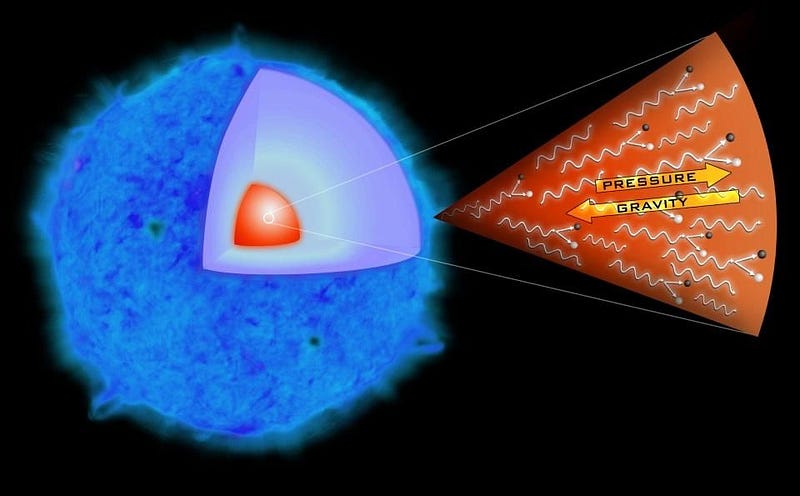
In January of 2020, a novel paper came out, demonstrating that the pair instability mechanism can’t explain the actual, observed light-curves of superluminous supernovae. Instead, they realized, previously ejected material could have shrouded two stellar cores, which then merged to produce a supernova. That would have explained previous superluminous supernovae, such as SN2006gy.
Now, on the other hand, a new superluminous supernova (SN2016aps) comes along, and it blows everything else out of the water. Based on the light we observed and the distance to its faint host galaxy that was later determined, 3.6 billion light-years away, we saw something unprecedented: an event so bright it radiated over 500 times the energy of previous, typical supernovae. No supernova, not even any previous superluminous supernova, have ever matched it.
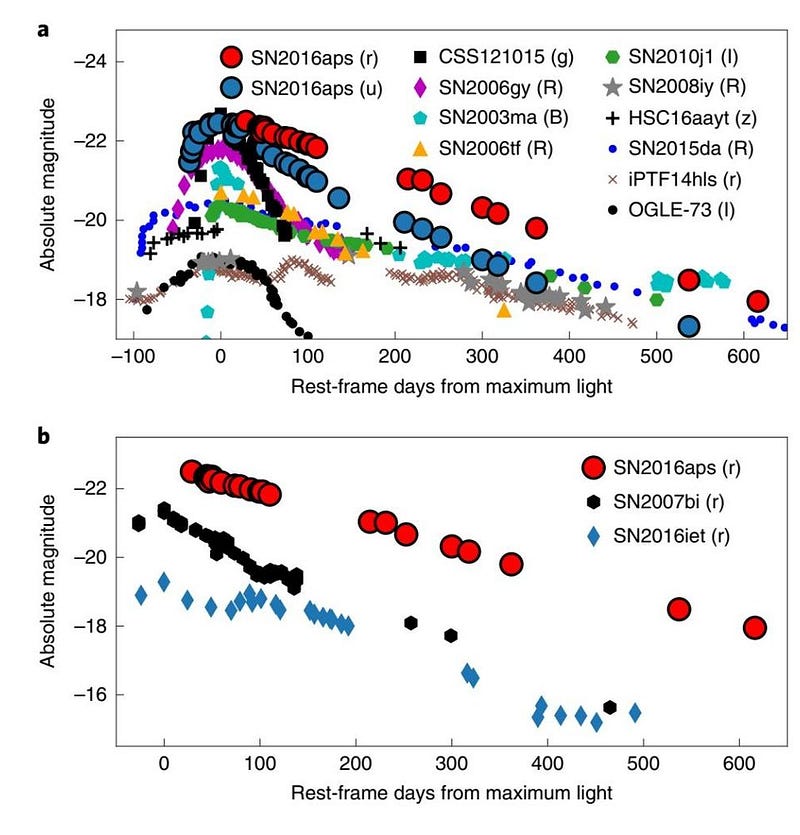
You might wonder, quite reasonably, if it might be a different sort of transient event. After all, there are all sorts of bizarre cataclysms that occur when stars die. There are tidal disruption events, where stars are torn apart by gravitational effects. There are supermassive black holes that suddenly activate at the centers of galaxies, emitting enormous jets of radiation. And there are kilonovae, formed from the mergers of neutron stars.
This is clearly none of those. There’s clearly a hyper-energetic explosion happening all at once, disfavoring tidal disruptions. It’s offset from the center of its faint, low-mass galaxy, indicating that it’s not accretion onto a supermassive black hole. It faded away very slowly and contained too much hydrogen, eliminating the kilonova possibility. All that’s left, based on the data (including the light spectrum), is that this is a superluminous supernova, but a brighter one than ever before.

Based on what they observed, the 17 scientists involved with the study then went and simulated what sort of cataclysmic explosion could reproduce the various features that they observed, and came to a shocking conclusion. This can be modeled with a superluminous supernova, but only if it’s larger than anything ever seen before. In particular:
- there needs to be an enormous amount of mass recently ejected (decades or centuries, at most, prior): at least tens of solar masses worth of material,
- the mass of the star’s core must also be enormous: more than 50 solar masses worth of material heavier than hydrogen needed to be in the core before the explosion went off,
- and the supernova itself must have ejected an enormous amount of matter incredibly rapidly: again, at least tens of solar masses worth of material, at speeds around 6,000 km/s, or 2% the speed of light.
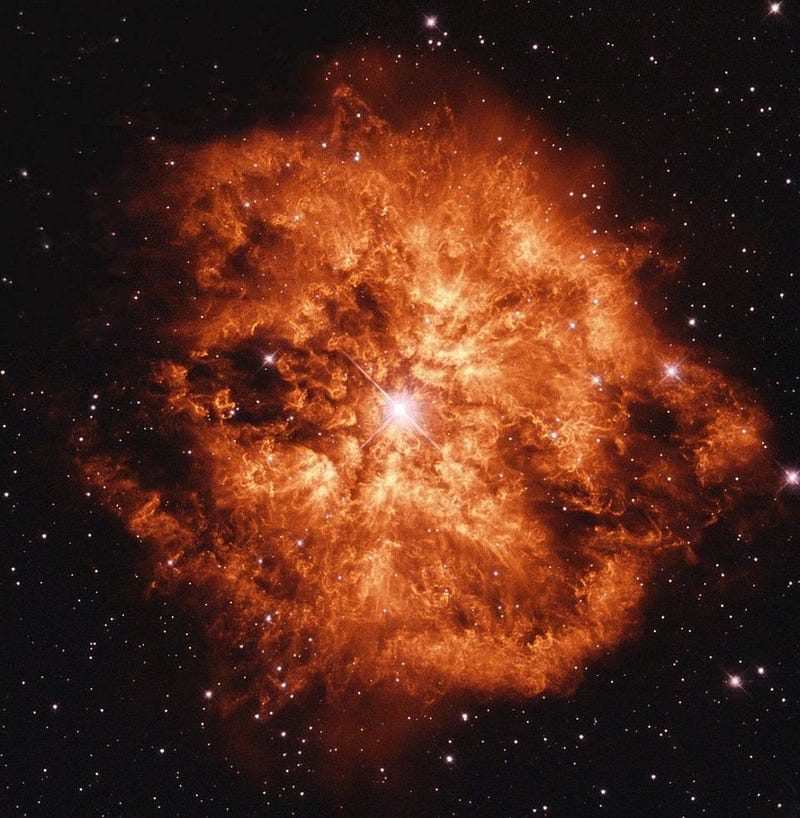
Now, here’s where things get really fascinating. First off, all scenarios that recreate these conditions require massive behemoths of stars: stars of 100 solar masses or even greater amounts. After that, the authors find two ways to go about reproducing something this bright. One way is to have a star have an enormous disruptive event followed by a pulsating pair-instability supernova, resulting in a rapidly spinning magnetar at its core. These are exceptionally rare events; the authors estimate that only 1-in-10,000 core collapse supernovae could wind up this way.
But you could have a massive multi-star system instead, where one of the stars undergoes a pair-instability supernova but the other member provides the circumstellar material. This should be even rarer — perhaps a 1-in-50,000 event — but we have environments with these massive multi-star systems known to us right next door: in the Tarantula Nebula in the Large Magellanic Cloud.
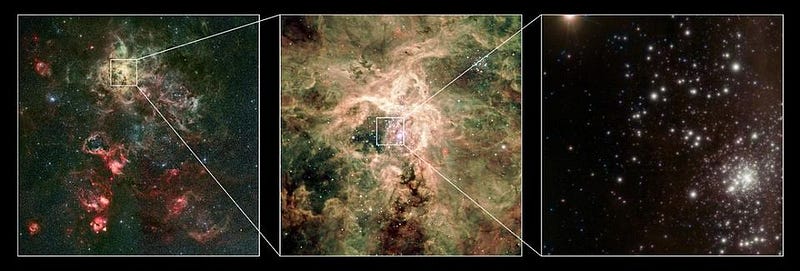
Only perhaps a dozen superluminous supernovae have ever been observed, and this one takes the cake as far as its absolute brightness is concerned. In terms of brightness, energy, and the inferred mass of the progenitor star — whose best-fit estimate is over 150 times the mass of our Sun — no other supernova ever seen can compete. There really are stellar explosions out there so energetic that they outstrip anything ever seen before.
There’s still so much to learn about these classes of objects: whether their afterglows are radioactive, how massive their progenitors are, whether they come from single or multi-star systems, and how frequently they occur. With the Vera Rubin Observatory and James Webb Space Telescope both coming online soon, we’ll be able to detect, classify, and spectroscopically measure these objects more than halfway to the edge of the observable Universe. We’ve just seen the tip of the iceberg, and later this decade, we’ll truly find out what lies beneath the surface of our cosmic ocean.
Ethan Siegel is the author of Beyond the Galaxy and Treknology. You can pre-order his third book, currently in development: the Encyclopaedia Cosmologica.





